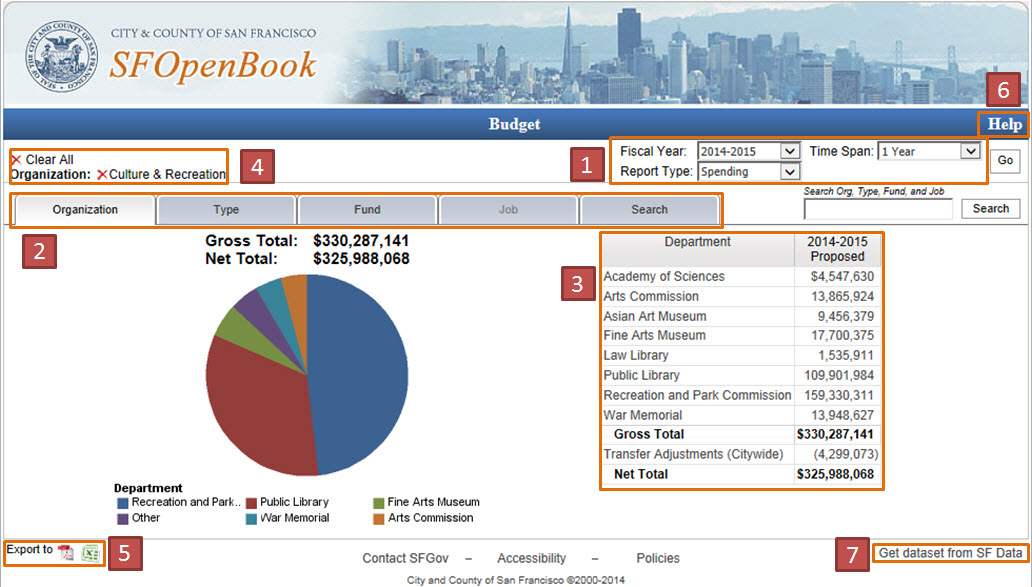|
|
|
How to Use SFOpenBook - Budget
Table of Contents
Site overview
Here is a step by step walk through of the design of the site.


Select Filters. You can choose which Fiscal Year you’d like to
view data from, how many years of data you’d like to view (1 Year or 5
Years), whether you’d like to view budgeted City Spending (money going
out), budgeted City Revenue (money coming in), or budgeted FTEs (full-time equivalents). Click Go after you
have made your selections.
The site defaults to the Current Fiscal Year, One Year, and Spending.

Select a Tab. You can begin viewing data by Organization (this
is where you will find Departments and Programs), Type (where you will
find different kinds of spending such as Salaries or Materials &
Supplies), or Fund (where you will find various funds such as the
General Fund or Port of San Francisco Funds.) The job tab is only available if you have selected the Staffing (FTE) report type.
You can switch among the Tabs as you "drill down" in the data (instructions on how to "drill down" are in Step 3.)

"Drill down" in the data by selecting one of the options in the
Data Table. From the Organization Tab, you can select the "Culture
& Recreation" Org Group to view the Departments within it, which
include the Fine Arts Museum and Asian Art Museum, among others. See
the Department List to find which Organization a Department belongs to, and the Examples section for some possible drill-downs.
Once you have made a selection, you can also switch to a different tab.
For example, from Asian Art Museum you could select the Type tab to
view the types of spending that occur in that Department, which include
Salaries and Non-Personnel Services, among others.

The "breadcrumbs" on the top left will show you where you have drilled. To move backwards, select the  next to the individual filter. To return to the very beginning, select the next to the individual filter. To return to the very beginning, select the  next to Clear All. next to Clear All.

To export the data to a Microsoft Excel Workbook or PDF File,
select the PDF or Excel icon next to "Export to." This will export the
data table and pie graph on the tab that you are currently viewing.

For questions, select the "Help" link at any time.

To download all the data (at its lowest level of detail) used in this site, click "Get dataset from SF Data."
Diagram of site structure
There are three levels of detail for each tab. Clicking on the text in
a data table will take you to the next level of detail. For example,
clicking the Org Group "Public Protection" from the Organization tab
will bring you a list of Departments that fall into that category, such
as Police.
Please refer to the Glossary for definitions of these levels of detail.

How do I search for information on this site?
The Search function searches the data file that populates the
Spending and Revenue report. The most effective way to find what you
are looking for is to search one relevant or included word. For
example, if searching for the department Children, Youth & their
Families, type "children" into the Search field.
Should I use the back button while using the site?
No. To return to the SFOpenBook page simply close Spending and Revenue (it opens in its own window).
Don't use the Back button while drilling down through organization, department, program, fund, or type searches. Instead, use the  on the left of each line of your filter history to move backward through the information that you have brought up. on the left of each line of your filter history to move backward through the information that you have brought up.
Here is an example of filter history, which appears above the graph and data table:

For example, if you clicked the  to the left of Public Protection in the example above, you would see Permanent Salaries-Uniform for all organizations. to the left of Public Protection in the example above, you would see Permanent Salaries-Uniform for all organizations.
How do I download the data I find on this site?
Information can be downloaded into a Microsoft Excel workbook or PDF file by clicking on the icon at the bottom of each page:

This will export the data on the tab that you are currently viewing.
|
|
|